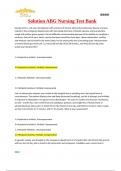Solution ABG Nursing Test Bank
George Kent is a 54-year-old widower with a history of chronic obstructive pulmonary disease and was
rushed to the emergency department with increasing shortness of breath, pyrexia, and a productive
cough with yellow-green sputum. He has difficulty communicating because of his inability to complete a
sentence. One of his sons, Jacob, says he has been unwell for three days. Upon examination, crackles
and wheezes can be heard in the lower lobes; he has tachycardia and a bounding pulse. Measurement
of arterial blood gas shows pH 7.3, PaCO2 68 mm Hg, HCO3 28 mmol/L, and PaO2 60 mm Hg. How
would you interpret this?
A. Respiratory Acidosis, Uncompensated
B. Respiratory Acidosis, Partially Compensated
C. Metabolic Alkalosis, Uncompensated
D. Metabolic Acidosis, Partially Compensated
Carl, an elementary student, was rushed to the hospital due to vomiting and a decreased level of
consciousness. The patient displays slow and deep (Kussmaul breathing), and he is lethargic and irritable
in response to stimulation. He appears to be dehydrated—his eyes are sunken and mucous membranes
are dry—and he has a two-week history of polydipsia, polyuria, and weight loss. Measurement of
arterial blood gas shows pH 7.0, PaO2 90 mm Hg, PaCO2 23 mm Hg, and HCO3 12 mmol/L; other results
are Na+ 126 mmol/L, K+ 5 mmol/L, and Cl- 95 mmol/L. What is your assessment?
A. Respiratory Acidosis, Uncompensated
B. Respiratory Acidosis, Partially Compensated
C. Metabolic Alkalosis, Uncompensated
D. Metabolic Acidosis, Partially, Compensated
A cigarette vendor was brought to the emergency department of a hospital after she fell into the ground
and hurt her left leg. She is noted to be tachycardic and tachypneic. Painkillers were carried out to
2024
, lessen her pain. Suddenly, she started complaining that she is still in pain and now experiencing muscle
cramps, tingling, and paraesthesia. Measurement of arterial blood gas reveals pH 7.6, PaO2 120 mm Hg,
PaCO2 31 mm Hg, and HCO3 25 mmol/L. What does this mean?
A. Respiratory Alkalosis, Uncompensated
B. Respiratory Acidosis, Partially Compensated
C. Metabolic Alkalosis, Uncompensated
D. Metabolic Alkalosis, Partially Compensated
Ricky’s grandmother has been suffering from persistent vomiting for two days now. She appears to be
lethargic and weak and has myalgia. She is noted to have dry mucus membranes and her capillary refill
takes >4 seconds. She is diagnosed as having gastroenteritis and dehydration. Measurement of arterial
blood gas shows pH 7.5, PaO2 85 mm Hg, PaCO2 40 mm Hg, and HCO3 34 mmol/L. What acid-base
disorder is shown?
A. Respiratory Alkalosis, Uncompensated
B. Respiratory Acidosis, Partially Compensated
C. Metabolic Alkalosis, Uncompensated
D. Metabolic Alkalosis, Partially Compensated
Mrs. Johansson, who had undergone surgery in the post-anesthesia care unit (PACU), is difficult to
arouse two hours following surgery. Nurse Florence in the PACU has been administering Morphine
Sulfate intravenously to the client for complaints of post-surgical pain. The client’s respiratory rate is 7
per minute and demonstrates shallow breathing. The patient does not respond to any stimuli. The nurse
assesses the ABCs (remember Airway, Breathing, Circulation!) and obtains ABGs STAT! Measurement of
arterial blood gas shows pH 7.10, PaCO2 70 mm Hg, and HCO3 24 mEq/L. What does this mean?
A. Respiratory Alkalosis, Partially Compensated
B. Respiratory Acidosis, Uncompensated
C. Metabolic Alkalosis, Partially Compensated
D. Metabolic Acidosis, Uncompensated
2024




